Is your grandmother’s sewing machine dangerous? 1948 Singer Sewing Machine in Table: 6,238 ppm Lead (in the gold paint).
Here’s a photo of my son wearing the first sewing project he made on his “new-to-him” vintage sewing machine this past week! It’s a hat (for clowning and unicycling while busking in Boston)!
Introduction (for those new to this website):
Tamara Rubin is a multiple-federal-award-winning independent advocate for consumer goods safety and a documentary filmmaker. She is also a mother of Lead-poisoned children (her sons were acutely Lead-poisoned in 2005). Since 2009, Tamara has been using XRF testing (a scientific method used by the U.S. Consumer Product Safety Commission) to test consumer goods for toxicants (specifically heavy metals — including Lead, Cadmium, Mercury, Antimony, and Arsenic). All test results reported on this website are science-based, accurate, and replicable. Items are tested multiple times to confirm the test results for each component tested. Tamara’s work was featured in Consumer Reports Magazine in February of 2023 (March 2023 print edition).
Published: April 5, 2021
Some personal background here — I actually have quite a bit of experience with vintage sewing machines…
(Scroll down to the bottom if you want to skip my story and just read the XRF test results!)
When I was in undergraduate school at New York University (1987-1990), I was around antique industrial Singer sewing machines almost every single day. They were big black painted metal ones on wooden tables. Some were electric; some were original treadle models, in constant service since before my grandmother’s time — mechanically simple and robust, durable — and entirely powered by the movement of the operator’s feet!
My work-study job Freshman and Sophomore year (while I was getting my Bachelor of Fine Arts Degree at Tisch School of The Arts) was in the legendary costume shop at 721 Broadway in New York City — with Kitty Leech and Greg and Marty Finkelstein and many others. The costume shop peeps were like my family at NYU, and all of the work-study/interns (including me) with the shop had the honor and the privilege of building and sourcing/finding period and modern costumes for off-Broadway (and “off–off-Broadway!”) shows being produced and directed by NYU students and graduates. My memories from that time are so incredibly special — I need to write more about that at some point!
While I didn’t know it at first, it turns out I was studying to be a clown.
I was in NYU’s conservatory program for an undergraduate degree in Drama at the time. I started with the Circle In The Square theater’s studio (on Broadway — in 1987/1988 and 1988/1989 — during the time I worked at the costume shop), and then studied with the Experimental Theater Wing in Paris (and, through them, with the Theatre du Soliel in the Bois du Vincennes) before graduating NYU with my acting degree. I had a focus on mask and clown work (including Commedia dell’arte) and a minor in French (I was one of the very lucky people on this planet who had the opportunity to study circus arts with the legendary Hovey Burgess).
It’s really funny to me that now my kids are all becoming professional performers (and specifically, that they are embracing elements of clowning — unicycling, juggling, singing old and new humorous novelty songs — and other serious silliness — while professionally performing many different genres of music). They all also love making costumes just like I have since I was very young!
In addition to being a clown and making costumes, my second-eldest son likes to “upcycle” discarded items he finds on the street — ESPECIALLY if he thinks he can use them for his fantastic art projects!
My son A.J. is now 18 years old. From the time he was very little he was attracted to and liked to pick through “free boxes” of odds and ends at and after yard sales — and even picking up random trash set out by the curb on recycling days — and then do imaginative creative stuff with it! He was always finding things, from bits of metal to discarded toys … In fact, when my boys were first poisoned, A.J.’s was the first test result I got back and I initially assumed he was poisoned because he was always picking up gross stuff from the sidewalk (even at just 3 years old!) and doing gross things (like licking the glass walls of the bus stop as we waited for the bus)!
When he was super little, most of the stuff he picked up ended up in his mouth. In response, trying to put a stop to this, I bought him chewy toys and chewy necklaces and watched him like a hawk! I remember even into his early teen years finding him — to my horror — putting bolts and screws in his mouth to chew on! This is Pica, but in an absent-minded (“Hey, I wonder what it is like to chew on this?”) sort of way, not in an “I have the urge to eat non-food items” way. (Pica is a well-documented impact of Lead-exposure.)
As he got older and stronger (he is now a 5 ft 10 inch-tall, very-strong young man), the stuff he would pick up off the street got bigger — but still a lot of it was really gross! I think two years ago he brought home a rust-encrusted section of old train rail (an enormous, absurdly heavy length of cut-up original train track discarded near the old-railway-convereted-to-cycling path by our home). Another time he came home with what looked like a giant discarded military mortar shell he had found somewhere! A couple of years ago, he spotted and helped haul home the remarkably well-preserved 1948 Singer 15-91 reversible-feed electric sewing machine (below) that was just sitting by the curb in front of a house that was being demolished — that served as part of the inspiration for this post.
Continue reading below the images.

Before A.J. left for college, we found the sewing machine pictured above.
While I think perhaps it may have actually possibly been my youngest who originally spotted this 1948 sewing machine being discarded (a woman had moved out of her home and it was sold and was going to be demolished and they were trashing all of the remaining contents of the home, including this sewing machine) — Charlie’s love for finding exciting things on the street (things being discarded by others) was definitely inspired by more-than-a-decade of watching his big brother A.J. come home with random “treasures” all of the time. Charlie (at this point) is a little more discerning than A.J. was at his age, and when the boys found this they ran home and he said “Hey mom, I think this cool old thing might have Lead and you could write about it for your website! Let’s go get it!”
And thus we acquired a 1948 machine with all of the original accessories and hardware in the original wooden cabinet and with the original vinyl-topped stool — and it promptly joined the other “toxic treasures” in my storage unit full of Leaded stuff I have been collecting for my book and museum exhibit!
With all of the chaos and nonsense in my life over the past couple of years, I had not yet gotten around to writing about it until now — but I have long told everyone who I see or hear has one of these in their home that they can potentially be hazardous, typically with unsafe levels of Lead in the paint and enamels, and sometimes even with really high levels of Mercury in the decorative elements.
And then, just last week A.J. found another sewing machine — a 1970s reproduction of an antique Singer Sphinx machine (pictured below), in the trash of a home in Boston’s Back Bay.
Fast forward to last month and A.J., who is now in college in Boston, called me to tell me he “found something exciting in the trash on the street” … as it turned out, it was a vintage Singer replica (c. the 1970s) of an antique Singer sewing machine (originally sold c. late 1800s), pictured below. (Note: apparently — according to A.J. — there are gems like this in the streets of Boston available for free every day! lol)
A.J. is now an adult and he is a very smart young man (who knows how to identify and protect himself from potential Lead hazards), but he also really wanted a sewing machine so he could learn to sew that way (he already knows how to sew and knit by hand) so he called me right away to ask if the machine he found had Lead — and if so if it could be safe to use. #Sigh.
Continue reading below the image
How old is your Singer sewing machine? Here’s a website with more info!
Does this have Lead? Is it safe to use?
I told him YES it likely has unsafe levels of Lead (and possibly Mercury) and I would prefer that he not use it — but if he chose to, I know I can trust him to be safe. My advice to my adult son for using this safely:
- I suggested that he wipe it down really carefully and thoroughly (to make sure there was not any Lead dust on it from its previous residence)…
- and that he consider wearing disposable rubber gloves when using the machine.
- I also told him that if he found himself NOT using disposable gloves when using the machine, I would encourage very thorough hand-washing afterward…
- and I would (most important) want to make sure he is not ever snacking while using the machine!
Is a vintage sewing machine a likely exposure risk to the user?
While I don’t know for sure, my educated guess is that the Lead in the enamel paint on the machine itself is not necessarily bioavailable/ coming off (that would take some experiments to determine), and because my son is an adult and well-versed on safety precautions (and because it is enamel paint on metal — not a chalky crumbly paint like house paint) I would be ok with him using for a little while, until I can afford to buy him a newer (Lead-free) machine.
The Lead paint that is likely on the legs, feet, and pedal of the machine is another matter (as distinct from the paint on the machine itself) as those components have a different level of wear due to the anticipated usage and age, and are more likely to create hazardous dust from normal usage as intended.
Realistically, there are times industrial artists like A.J. may feel the need to just make exceptions for things like this. A.J. is an avid “maker” — an artist, inventor, leather craftsman, woodworker, blacksmith, machinist, and general fabricator — who really enjoys machine tools and mechanical things, and learning how mechanisms were constructed and how they work. So this machine he found in the trash represents a lot of opportunities for him besides simply learning how to use the sewing machine, and I trust him to be safe with it (plus, there are no small children or babies in his apartment and he is good at keeping his work area clean!).
That said, I would prefer that he not have it in his home — and that instead that he keep it in a workshop or storage unit), but being a college student that’s not possible for now. It’s challenging to weigh the risks and benefits of certain things as a parent of adult children (with the knowledge that we have). I do think there is some potential risk to the user (which likely varies by machine), and I think that each person should evaluate that for themselves. As with musical instruments — when things are a tool for learning (and when proper precautions can be taken) — I sometimes make exceptions. Here’s my post that discusses this in the context of instruments.
Why I’m sharing this with my readers
With all the above said, I wanted to make sure to share with you the XRF test results for the 1948 machine we found a couple of years ago (A.J. finding another old machine in the trash made me realize it was time to finally write this long-intended post!). As with everything I write and share, I do it so you can have the choice to make an educated decision about what you have in your home and how you let your children interact with those things. You may not have considered the possible risks associated with grandma’s sewing machine — and you have a right to know that in my experience these machines and often the hardware and legs of the tables they are built into, as well as the vintage appliance cords on the electric ones, always test positive for an unsafe level of Lead.
How much Lead is “too much” Lead?
For those of you visiting my website for the first time, please click this link to learn about the testing methodology used on the website. In general, I reference the amount of Lead that is the limit for Lead in modern items manufactured specifically for use by children. I use that as a reference in all of my posts because there is actually currently NO LIMIT AT ALL for total Lead content in modern items intended for use by adults and, in my educated opinion, the Lead limit for children’s items should be applied to all consumer goods (and anything that touches our lives — not just children’s lives!).
The amount of Lead that is considered unsafe in the paint, glaze, or coating of an item intended for use by children (for items made today) is anything 90 ppm Lead or higher. For the substrate of an item (the base material underneath the paint or coating — like the metal of the sewing machine, or the wood of a dresser) the hazard level is anything 100 ppm Lead or higher. This sewing machine was positive for Lead in the paint at levels of 6,000 ppm Lead and higher.
Of particular interest to me is the amount of Lead found in the cover of the original 1941 booklet for the 1948 machine — Lead, which is bio-available (comes off as micro-particulate Lead dust) to anyone who touches it. This (and the Lead on the electrical cord of the 1948 machine) are in a way more concerning to me than the Lead in the actual enamel/paint of the machine itself.
In my opinion, given the function and intended use of the machine, the original Leaded enamel of an appliance like this (as long as it is in good shape) is not necessarily as concerning as if it were (instead) an original kitchen appliance. For instance, if my son had found a vintage KitchenAid mixer in the trash (for example) rather than a sewing machine — that would have been a hard “no” for me.
The same goes for vintage typewriters — given the amount of sustained interaction your hands actually have with the high-Lead components (and that a vintage typewriter is a device whose very essence of the operation is perpetual hard impact of components that are often Leaded) — I don’t consider vintage typewriters safe for anyone to use (from a potential Lead-exposure perspective). Here’s a link to a post about a vintage typewriter here on the site.
XRF Test Results for the 1948 electric (plug-in) Singer Sewing Machine pictured.
Continue reading below the image.
#1.) On wood of table/cabinet of the machine: 30-second reading
- Lead (Pb): Non-detect
- Silver (Ag): 13 +/- 4 ppm
- Palladium (Pd): 8 +/- 3 ppm
- Zinc (Zn): 95+/- 22 ppm
- Iron (Fe): 1,570 +/- 193 ppm
- Indium (In): 40 +/- 8 ppm
Continue reading below the image.
#2.) On the black body of the machine: 30-second reading
- Lead (Pb): 5,681 +/- 550 ppm
- Zinc (Zn): 3,414 +/- 455 ppm
- Copper (Cu): 408 +/- 196 ppm
- Iron (Fe): 717,400 +/- 41,000 ppm
- Manganese (Mn): 4,410 +/- 589 ppm
Continue reading below the image.
#3.) On gold decorative elements of the machine: 30-second reading
- Lead (Pb): 6,238 +/- 662 ppm
- Zinc (Zn): 9,985 +/- 1,189 ppm
- Copper (Cu): 41,600 +/- 4,500 ppm
- Cobalt (Co): 4,312 +/- 1,256
- Iron (Fe): 757,700 +/- 46,000 ppm
- Manganese (Mn): 5,384 +/- 655 ppm
Continue reading below the image.
#4.) On the booklet cover of the original instruction book (dated 1941): 30-second reading
- Lead (Pb): 592 +/- 33 ppm
- Silver (Ag): 11 +/- 4 ppm
- Palladium (Pd): 9 +/- 3 ppm
- Platinum (Pt): 83 +/- 38 ppm
- Zinc (Zn): 40 +/- 16 ppm
- Iron (Fe): 1,666 +/- 192 ppm
- Indium (In): 33 +/- 8 ppm
As always, thank you for reading and for sharing my posts. Please let me know if you have any questions and I will do my best to answer them personally as soon as I have a moment (which may take a while given I have kids underfoot 24/7 these days!)
Tamara Rubin
#LeadSafeMama
Owner — Lead Safe Mama, LLC
The 1948 Machine


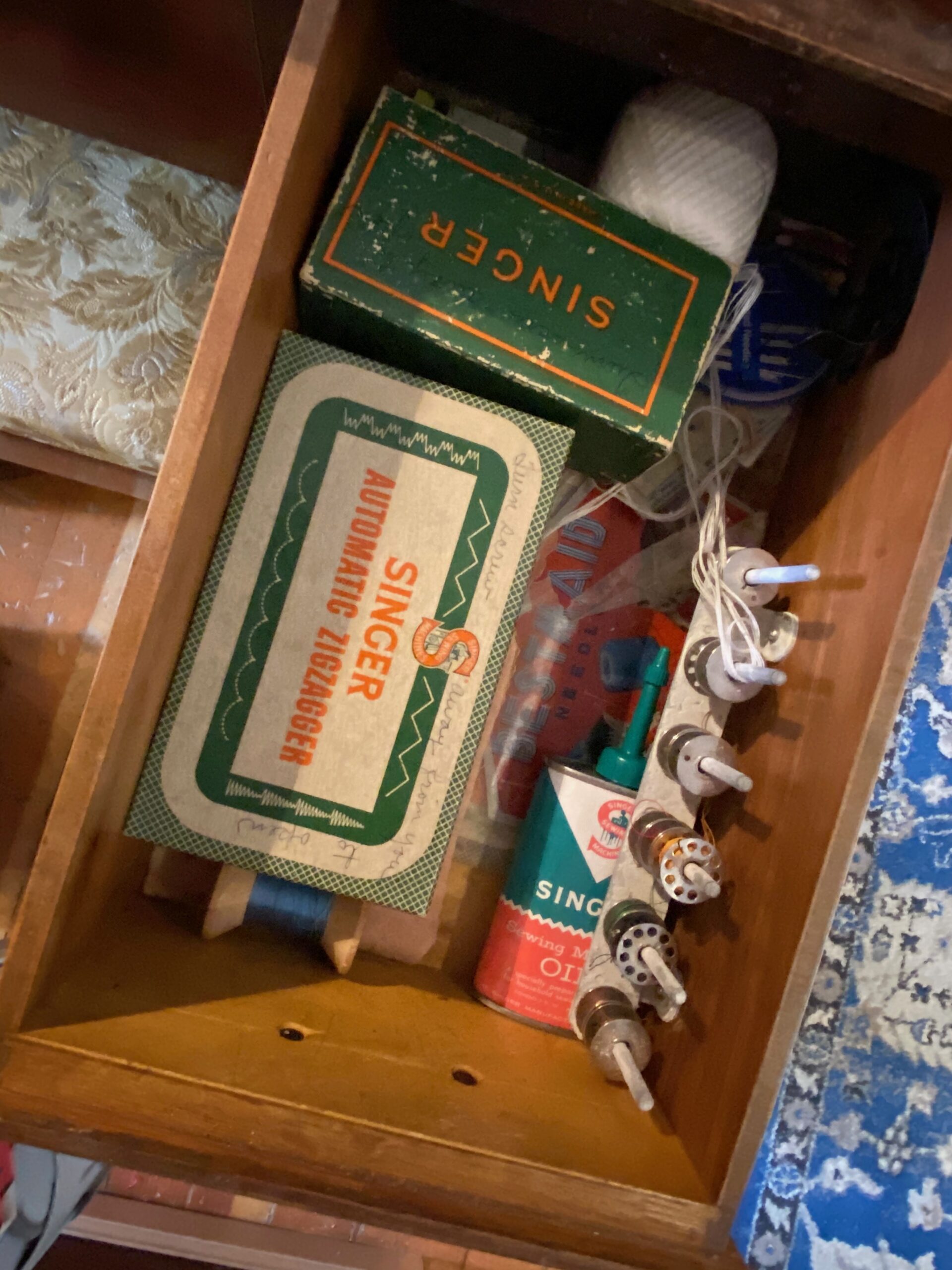
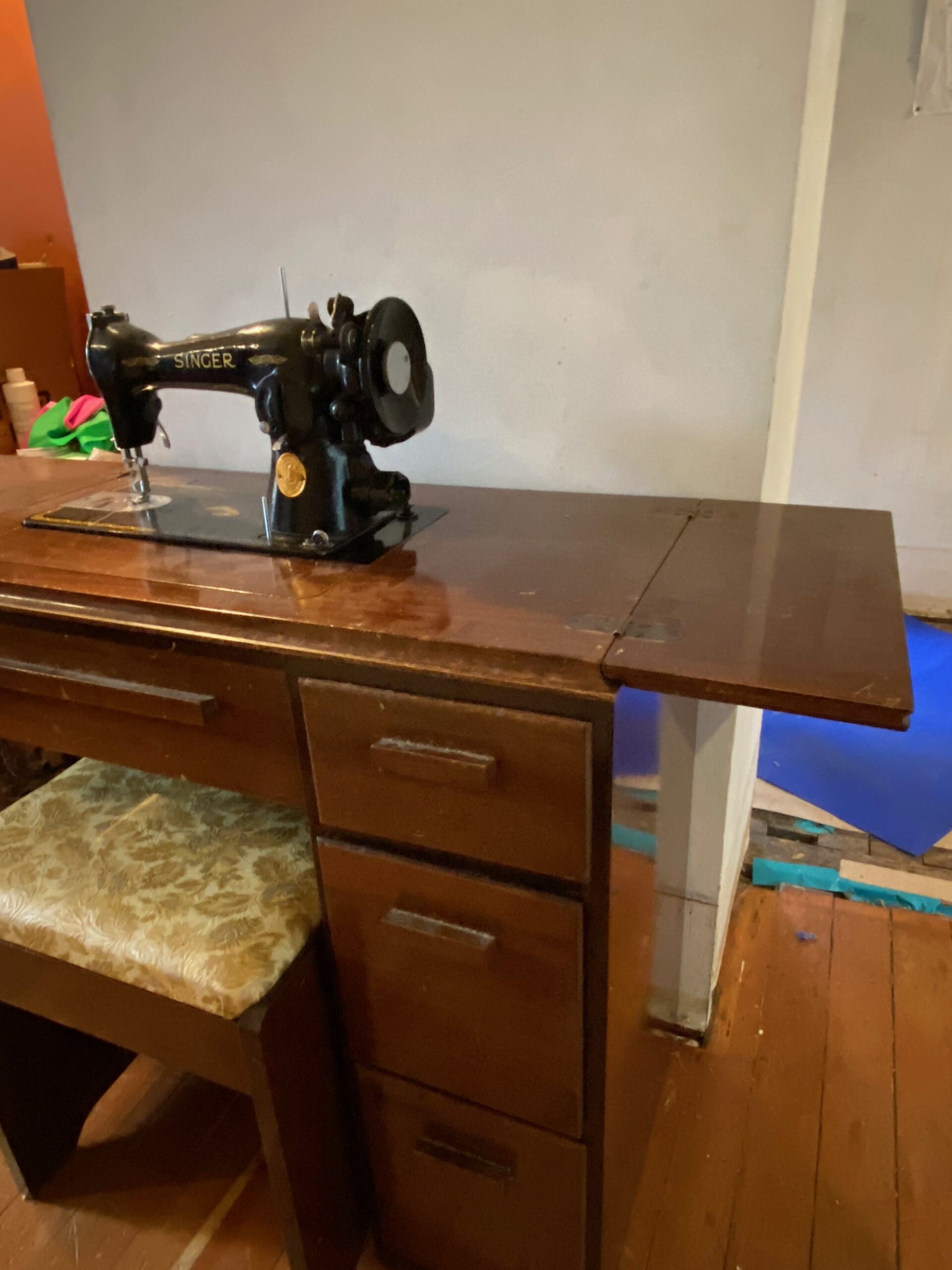
The 1970s Replica Machine
(the one my son found in Boston last month)
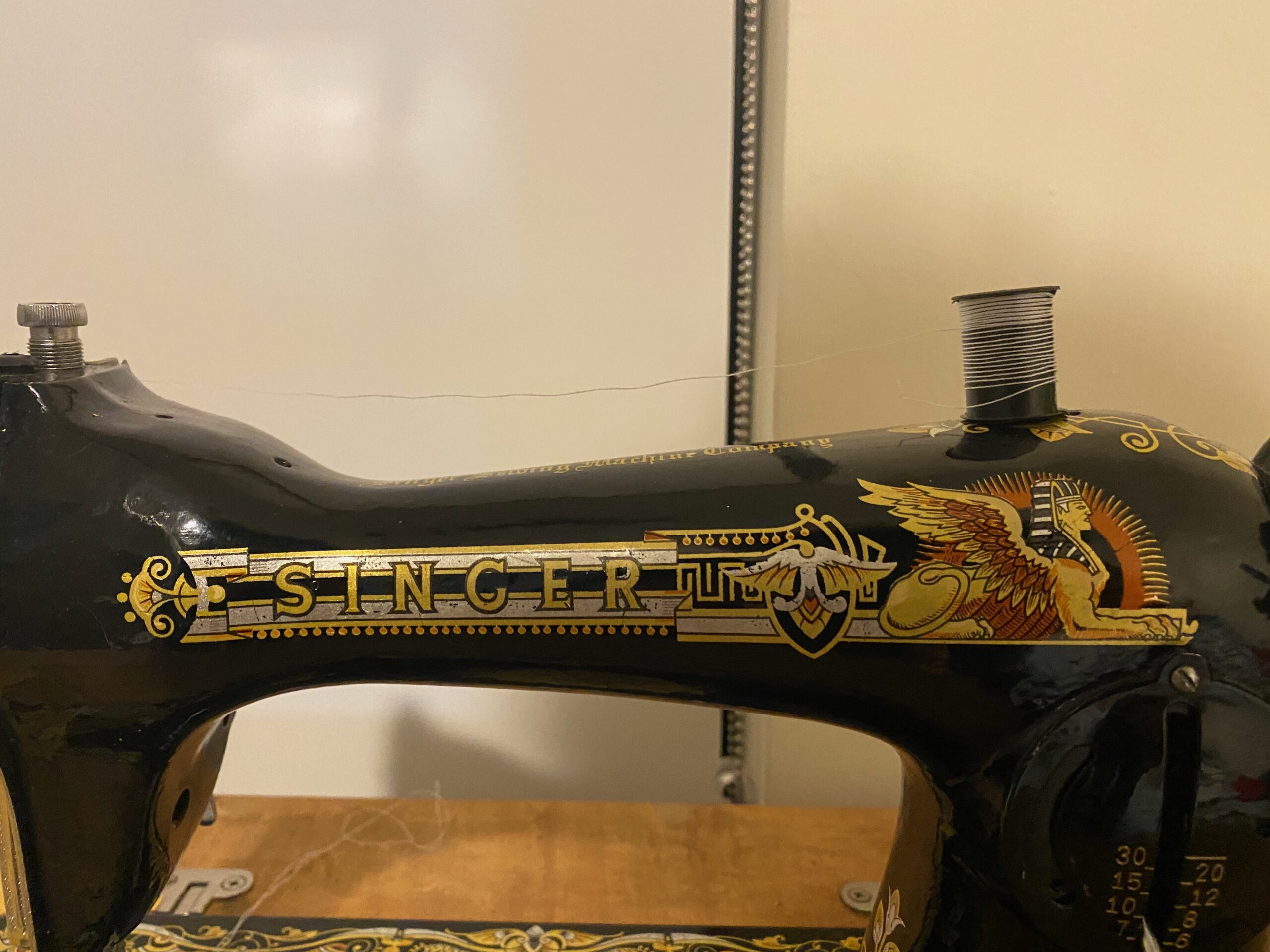
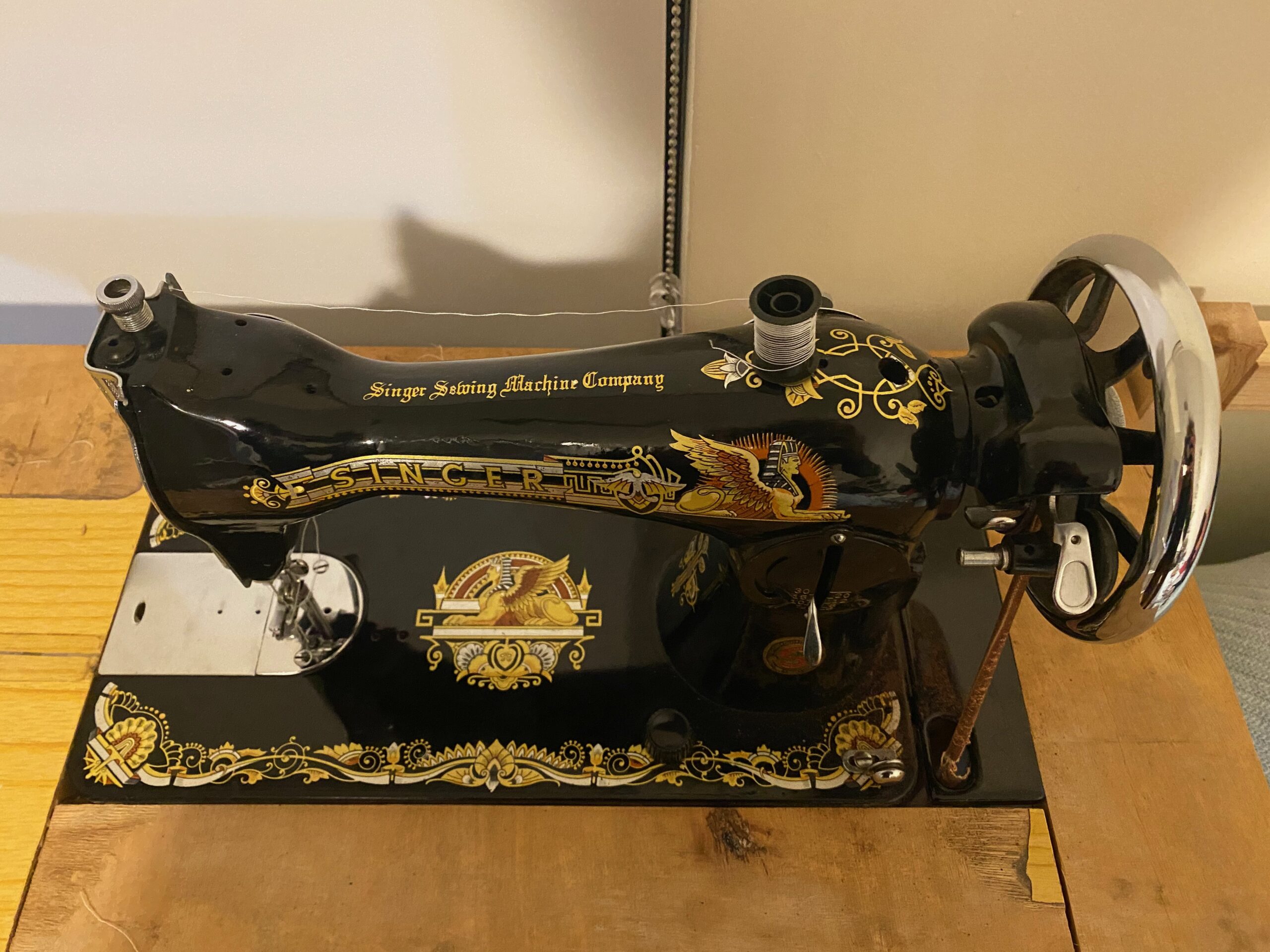
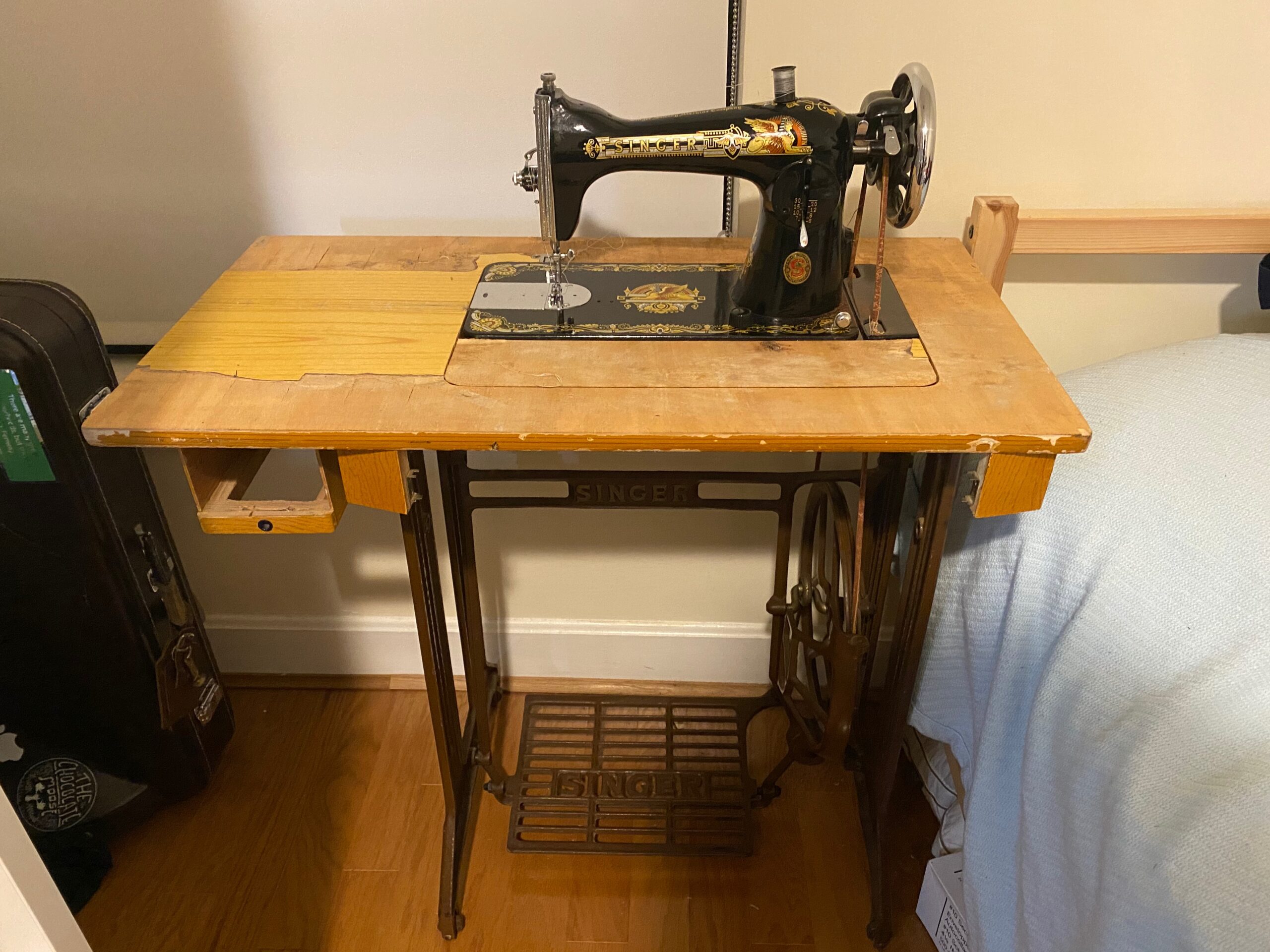
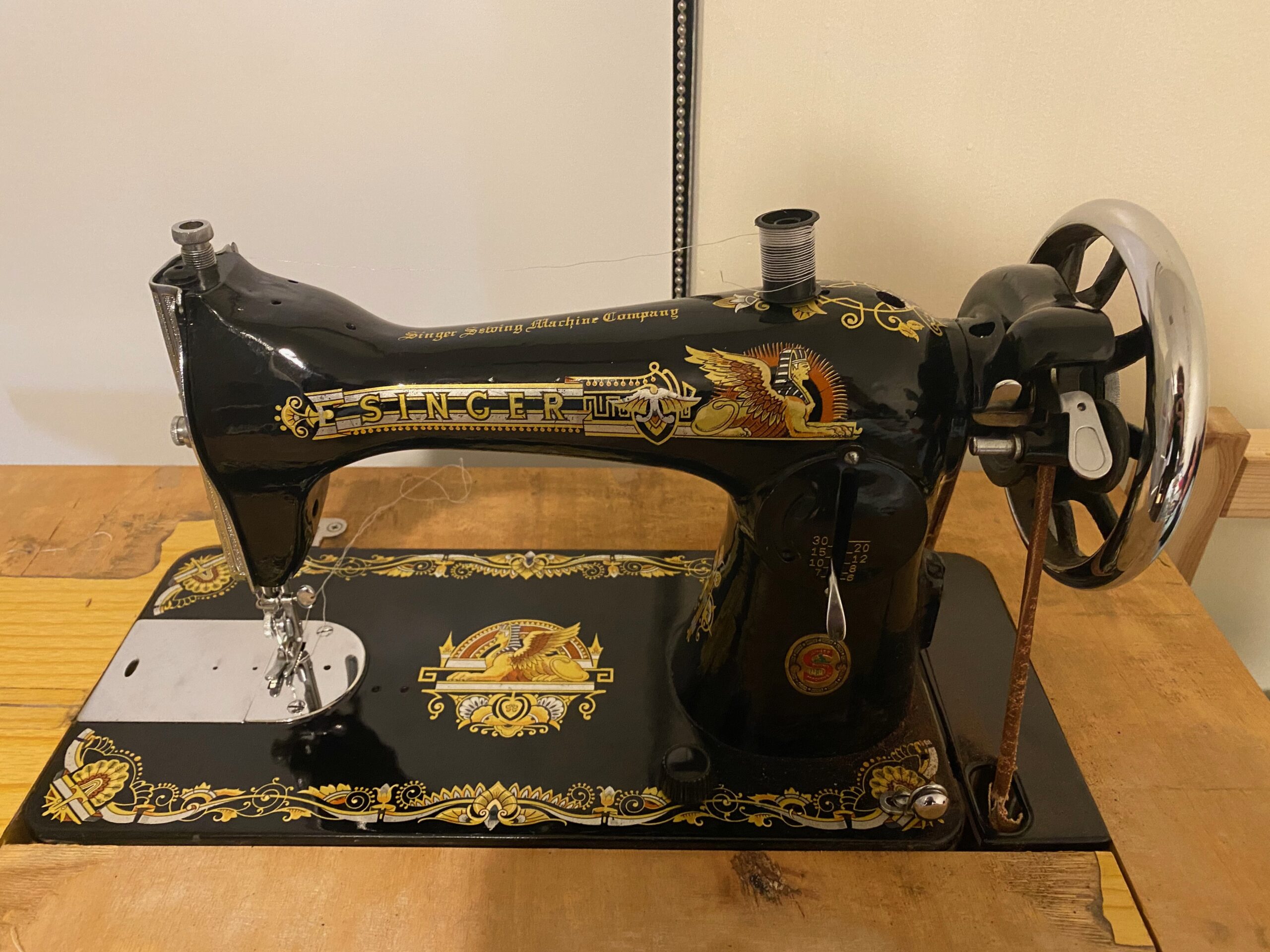
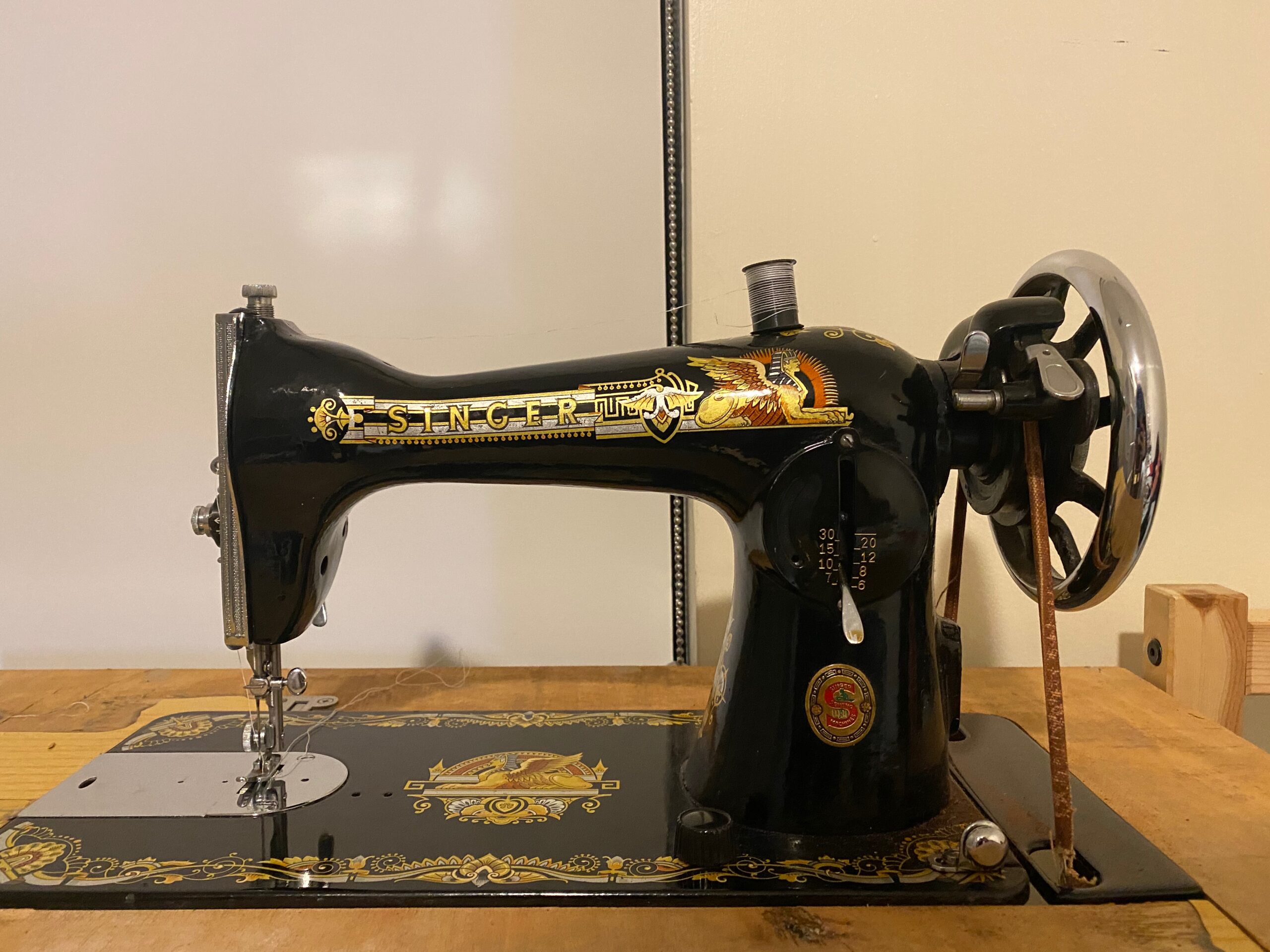
Never Miss an Important Article Again!
Join our Email List








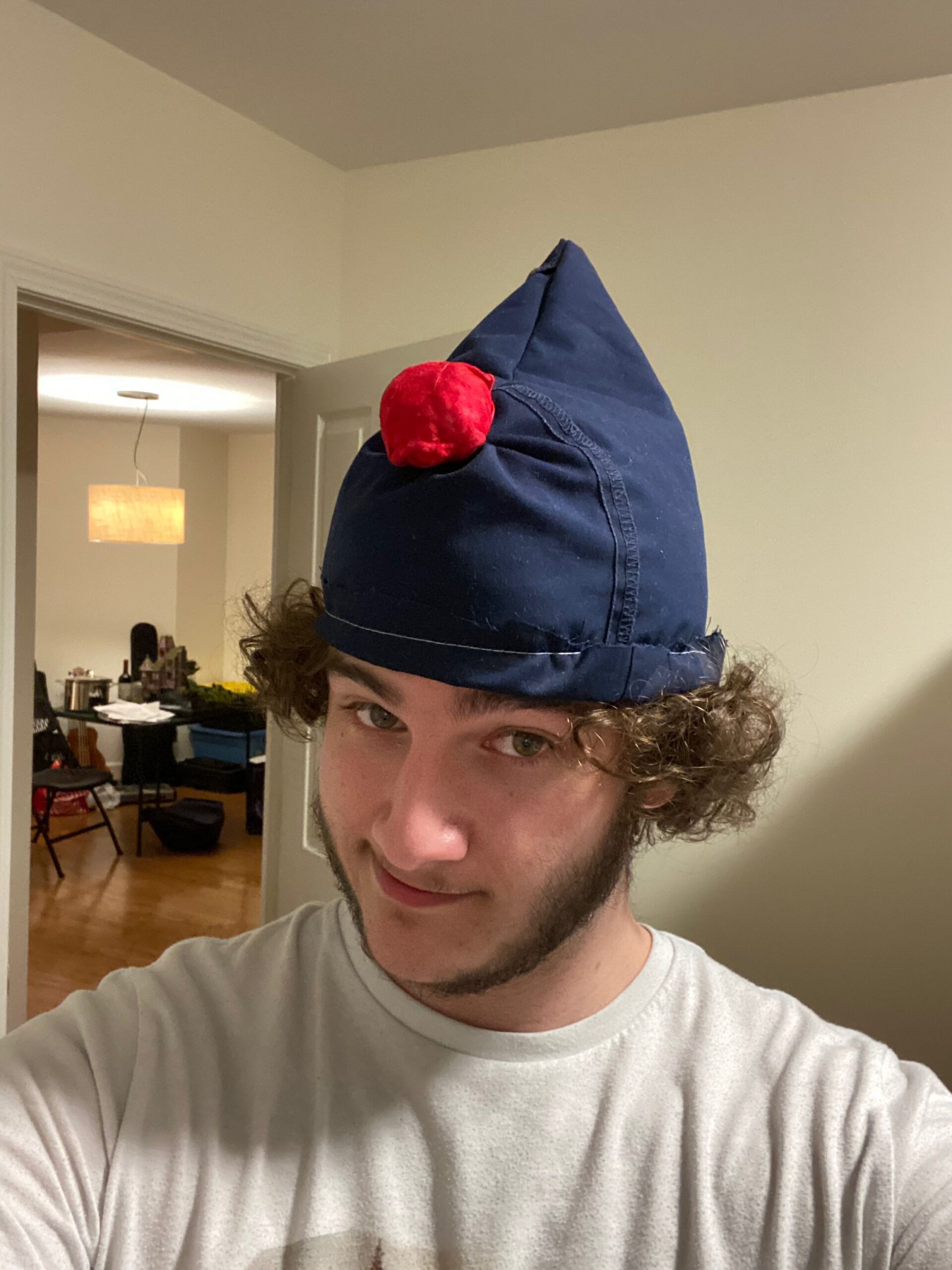
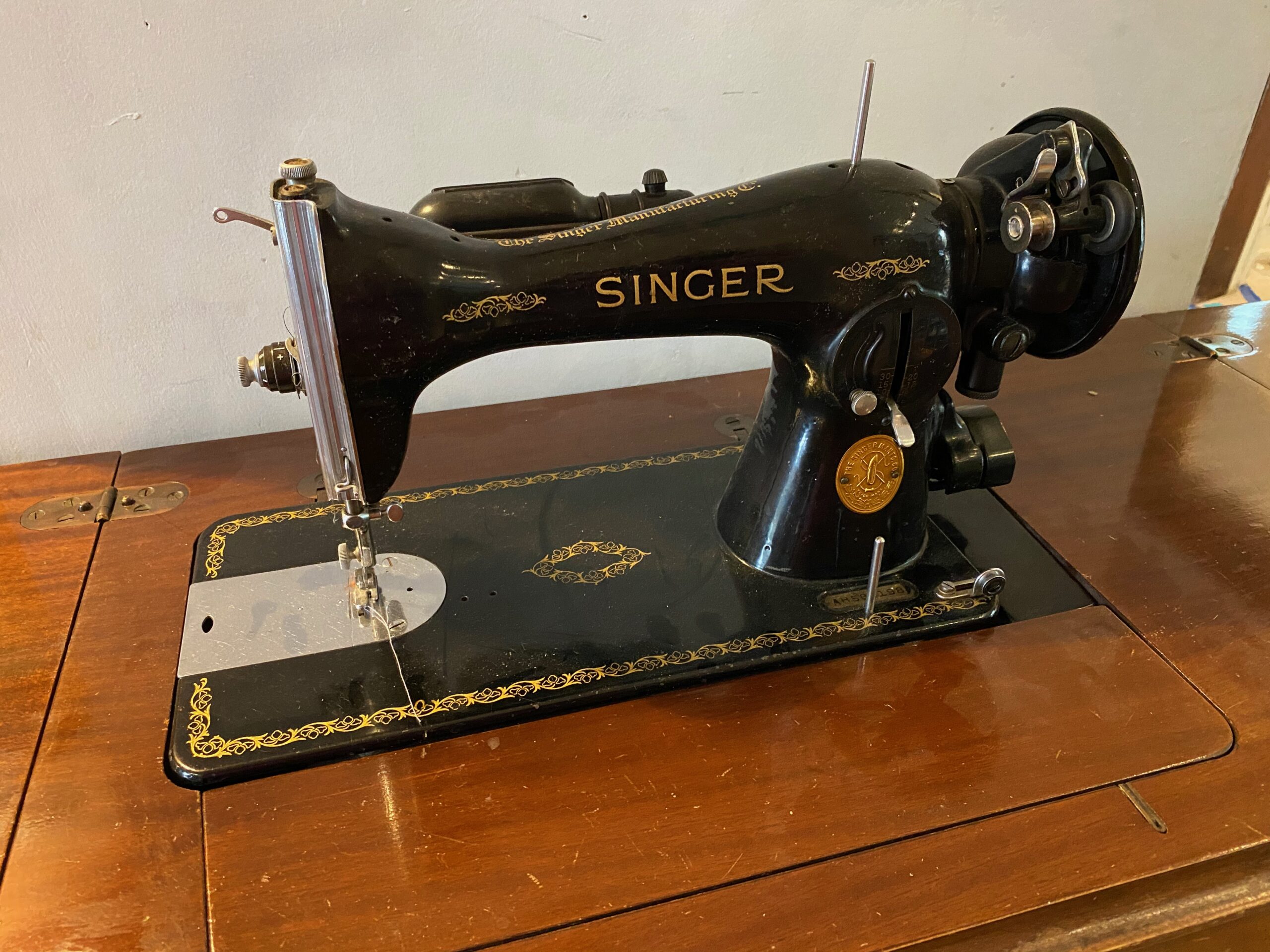
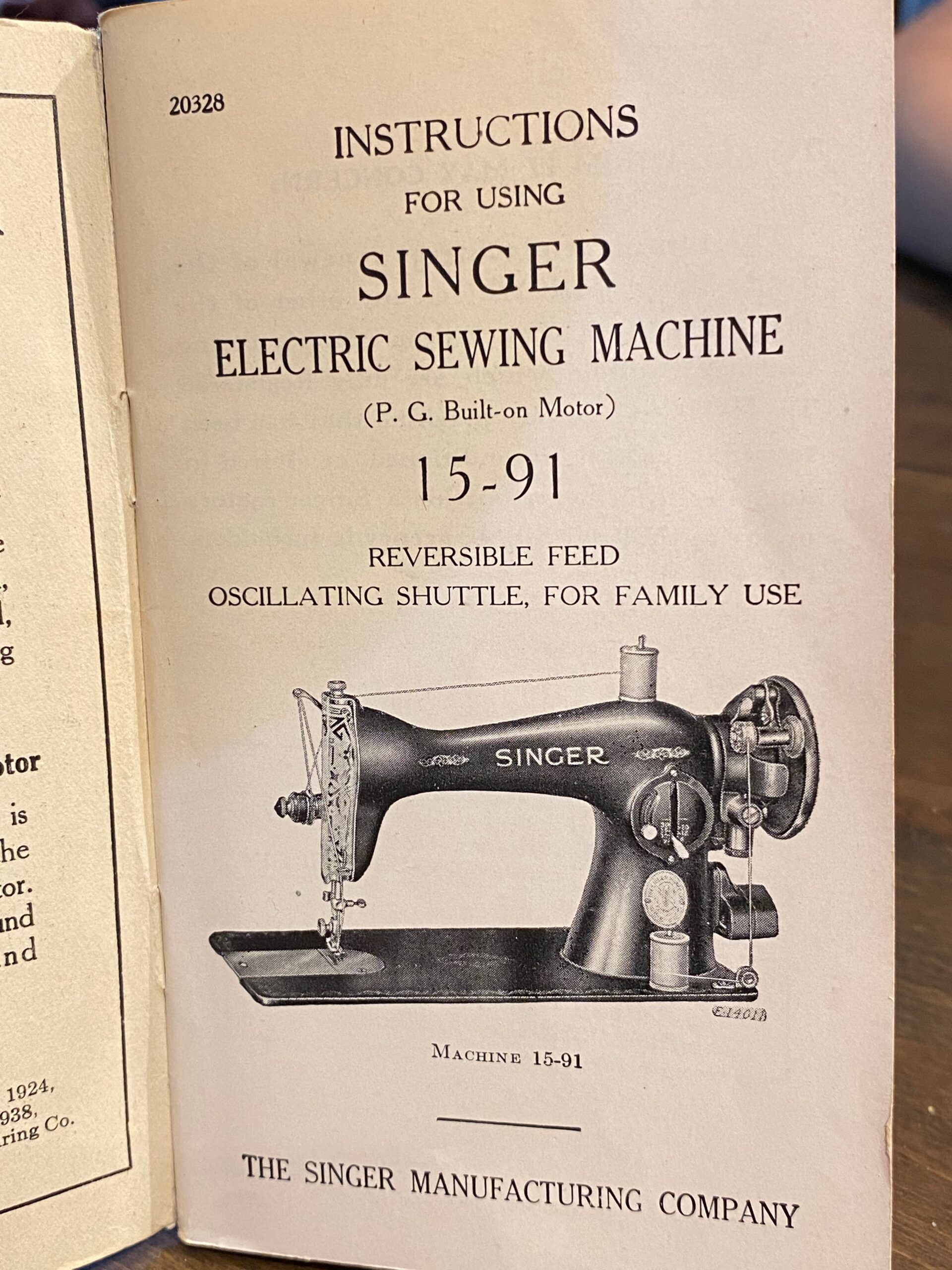
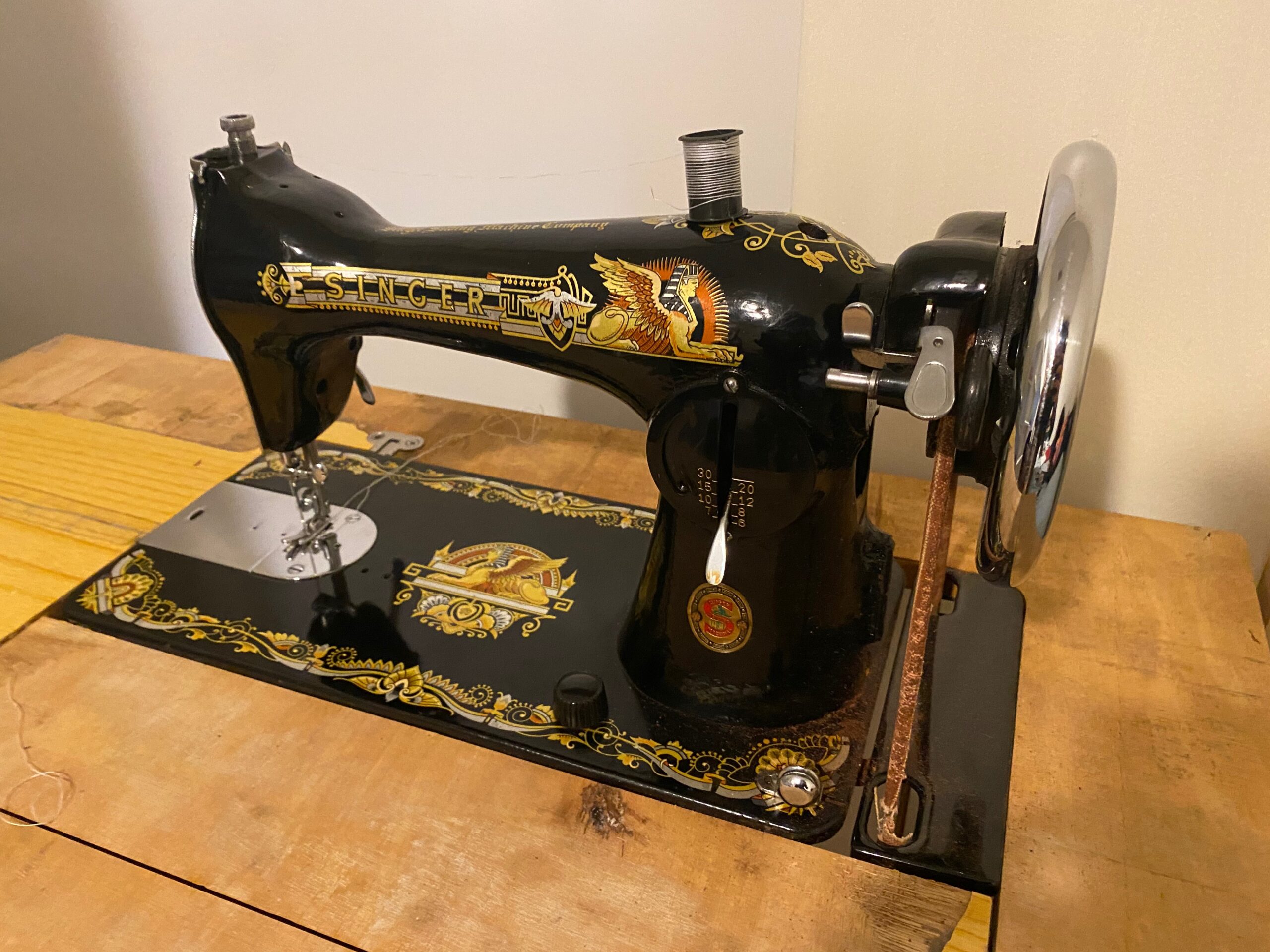
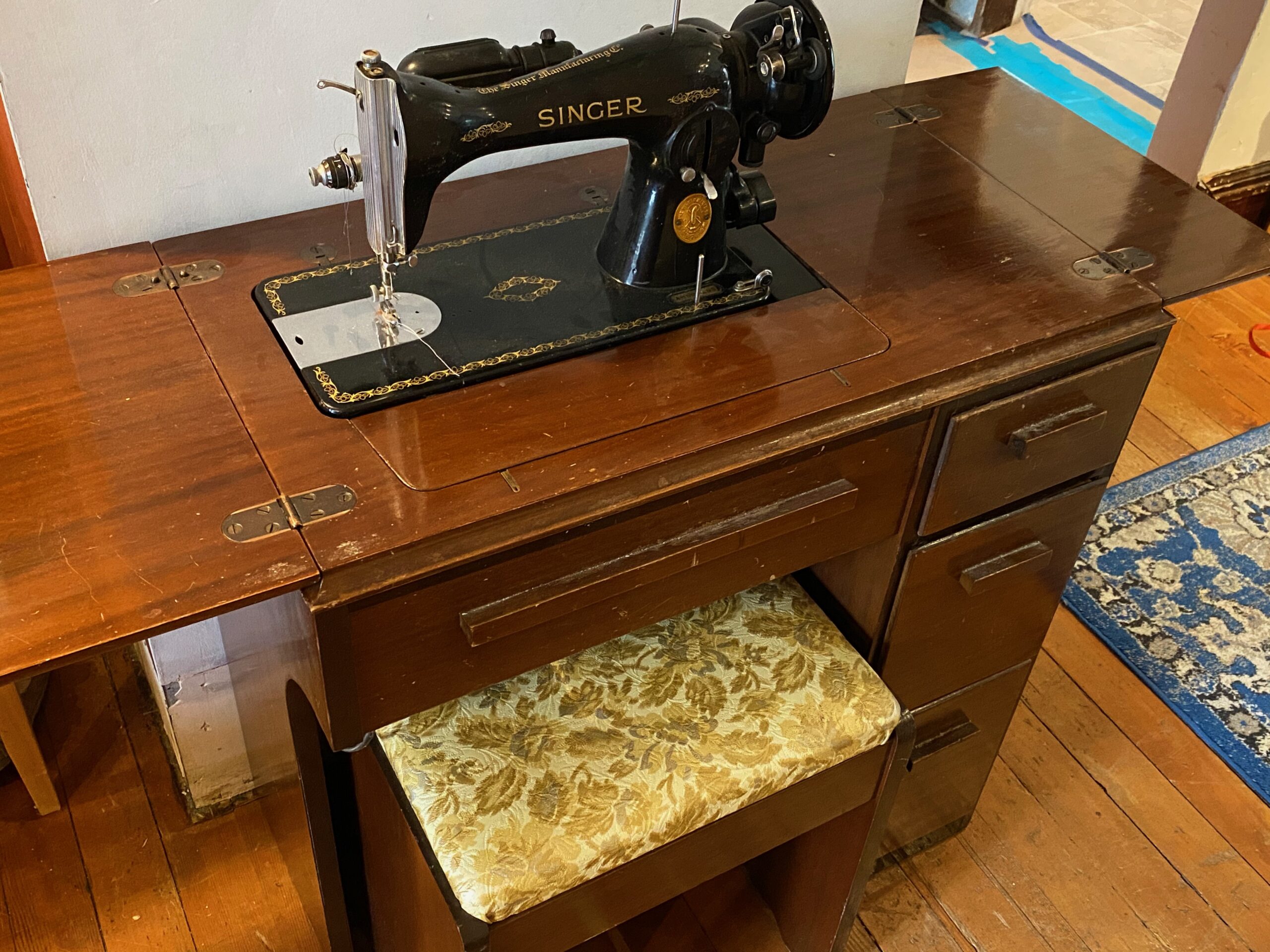
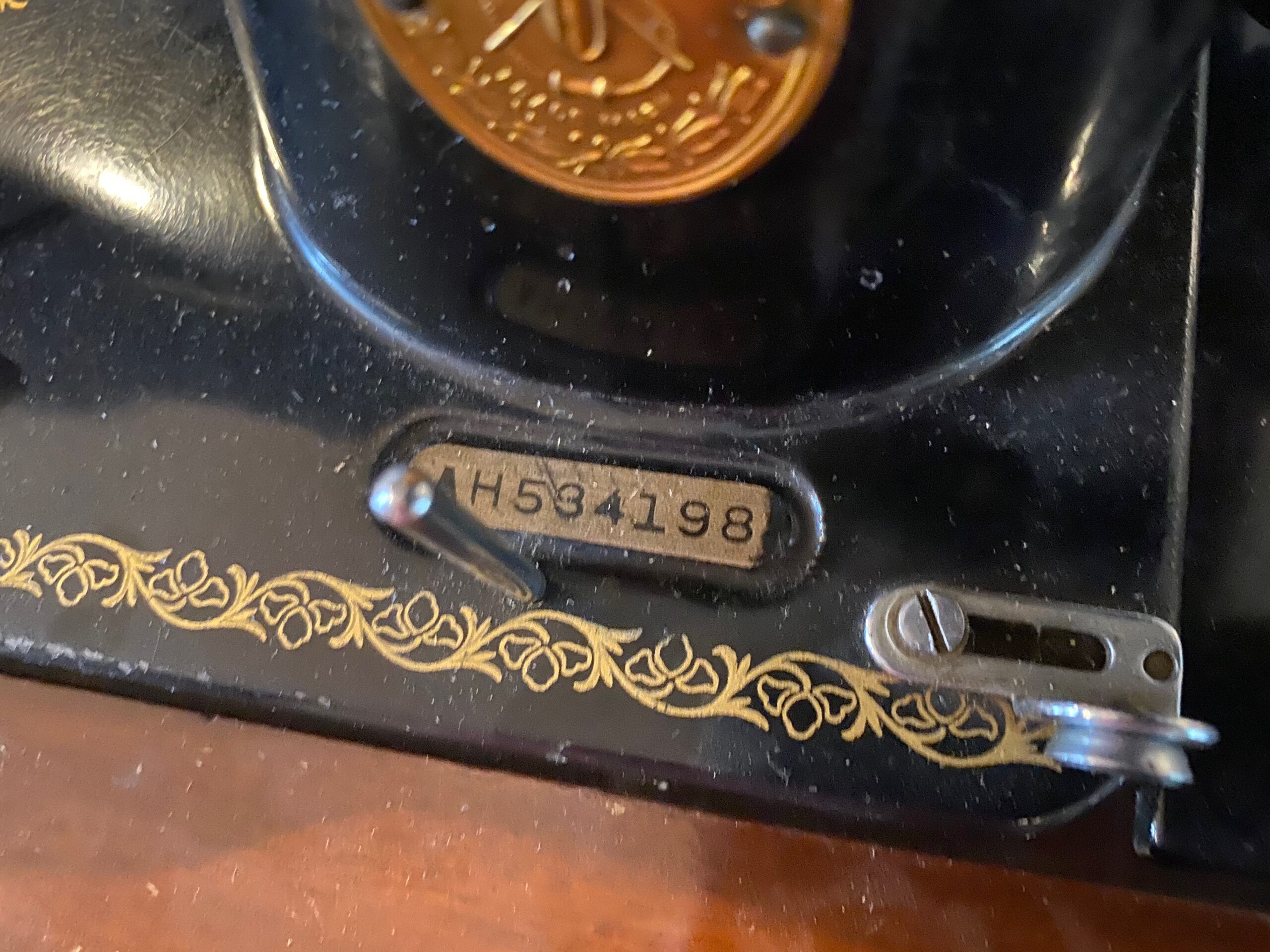
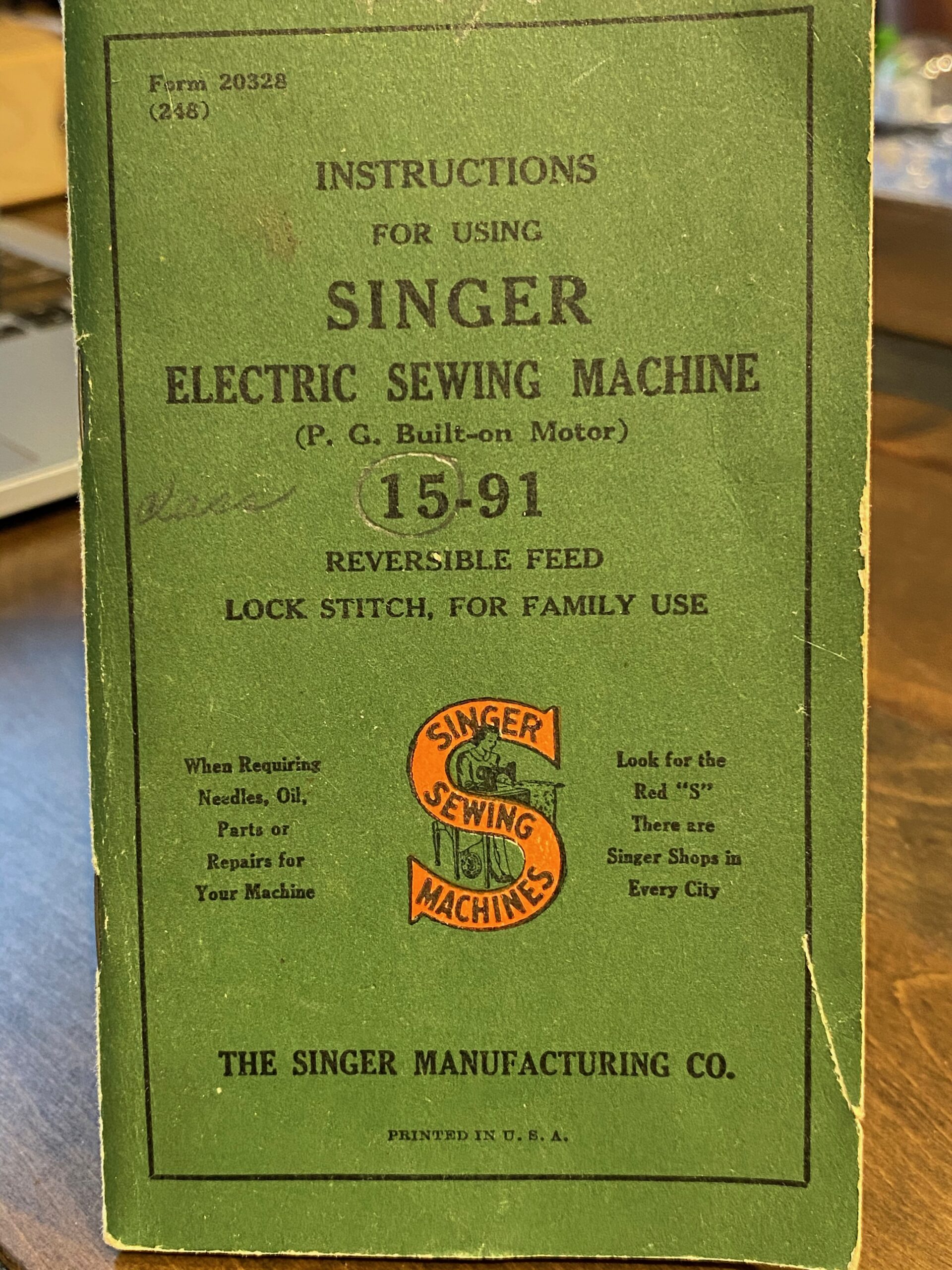
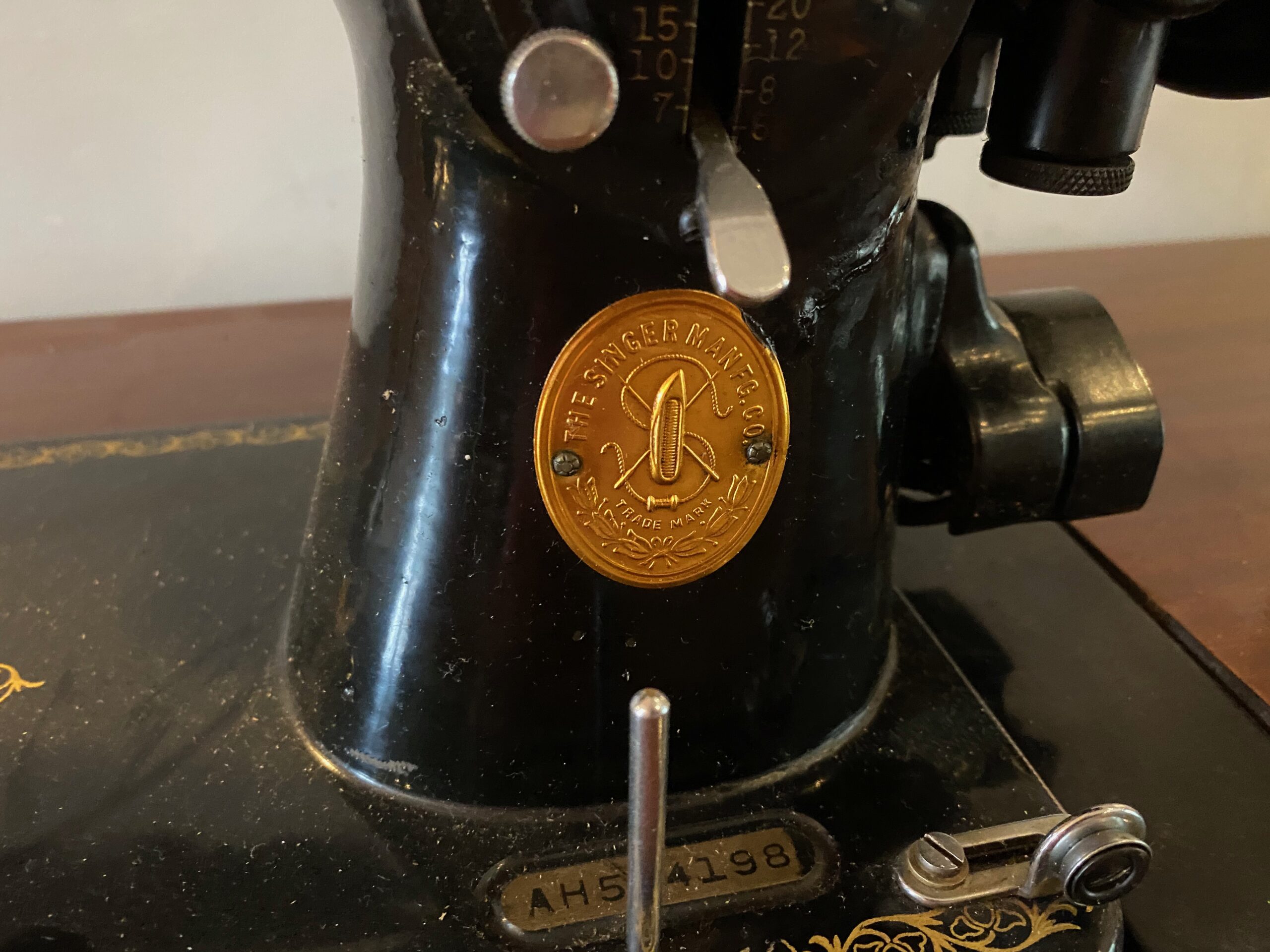
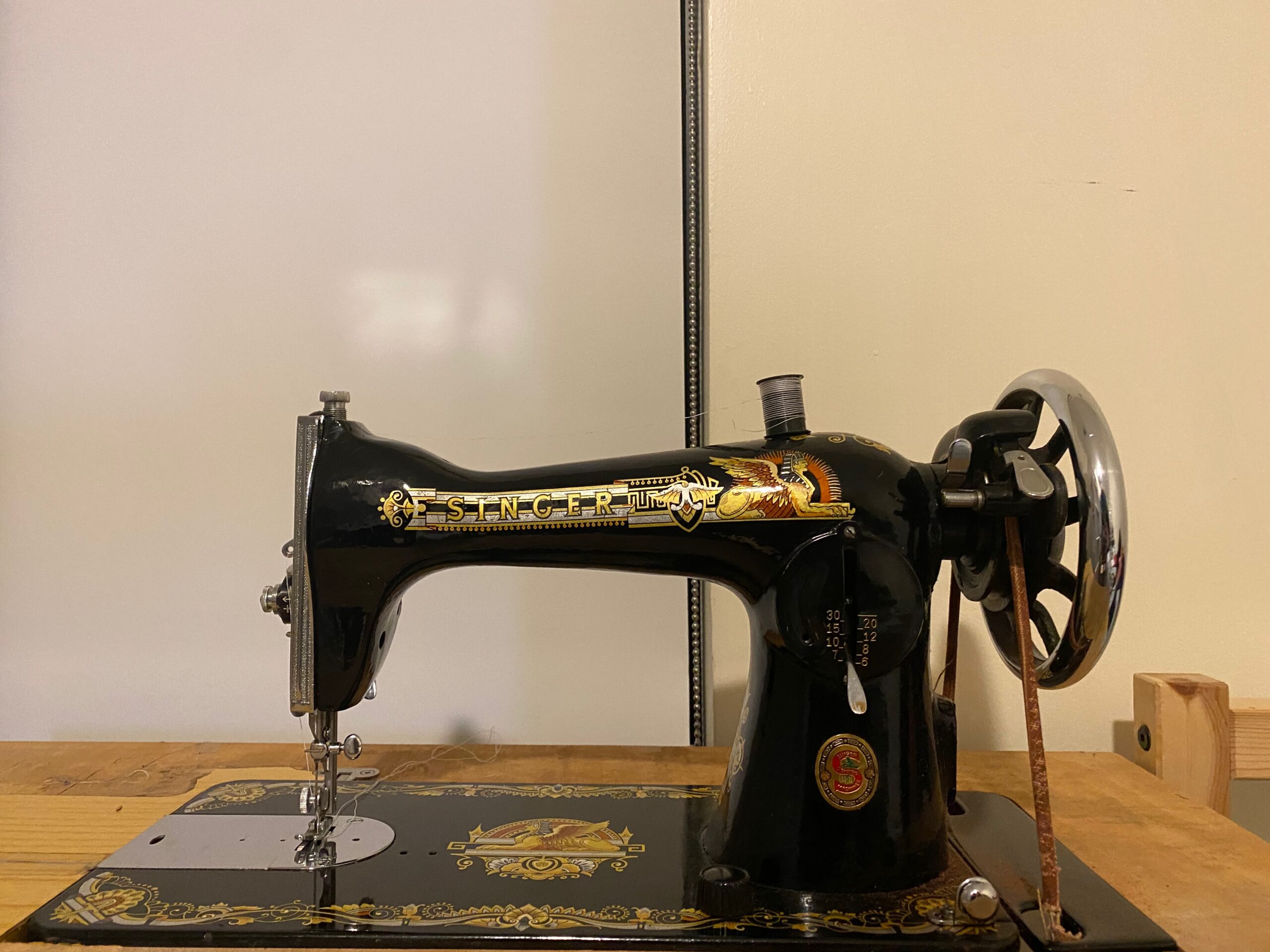

Thank you for this post! I actually have an old singer myself, but newer than these old black ones that are pictured. I guess a question I have though is, are the newer sewing machines any better? It seems like there are so many things that still have lead in them, from reading your posts. After reading this one, I was thinking maybe I should give up on having anything vintage, since all this vintage stuff is so high in lead. But then I remembered how much stuff still has lead, and I am just wondering if newer items, like a new sewing machine, would be much different in the lead readings? Thanks!
Sorry, I mean mine is newer than the oldest one pictured. Although, I think it might be pretty close. It’s not that black style though.
Is there ANY way to contain the lead on the machines? A coating perhaps? Thank you for mentioning wearing gloves. I guess a mask for dust would be in order, too. Guess i will use mine outdoors. It is funny that your article arrived in my feed just after i bought 2 old machines online! I was hoping to use one while RVing converting to a hand crank.
Certainly makes me aware of the other vintage metal things I may need to jettison. Thank you very much for your work.
If heavily waxed, do the same measurements occur?
I cant find a lead test for solid surfaces that tells how many ppm, like you are stating. They only tell if it’s too high, as in lead house paint. Can you tell me what test you used to get ppm?
Hi Kathy, I use a $50,000 X-Ray Fluorescence Spectrometer. Here’s a post with more details:
https://tamararubin.com/2016/12/ask-tamara-what-do-you-use-to-test-for-lead/
I do this testing and make the results available for free on my website because it is not accessible or affordable to most human beings.
Let me know if you have any questions after you read that link.
Tamara
Thank you for writing this. I have the exact same 1948 machine in table and was planning on moving it to my daughter’s room. I am glad I did a little research first. Now I don’t know how to dispose of it.
It’s a long shot, I know; but would you:
still have the cabinet? …be willing to part with it? … live anywhere near Santa Rosa CA?
My grandma sewed on her Singer treadle machine anything my mom could design.
I grew up wearing clothes my mother sewed on her later model Singer in the same cabinet as yours, but the seat cover was red. I was born in 1948.
I had that cabinet for many years with a newer model Singer in it… sitting next to my serger. My son got Christmas sweatshirts sewed on the serger… with my designs on the front appliqued with the Singer.
A house fire (totaled) and decades later, I’m looking for another cabinet like that long -ago one for my brand new Singer. But they all come with a machine.
I`m glad to have run across your blog. I, too, am kind of “junk” collector — odd bits — but MY thing is mobiles!
Did you find a cabinet? I’m in Sonoma county and have one.
The greatest danger with the electric vintage Singer sewing machines is risk of being electicuted by old wiring. The vintage machines are not grounded. As a hobby, I purchase only vintage 15-91 Singer machines and restore them. I rewire the motors and other wiring that usually needs it, and it is essential to have someone that knows what they are doing check the wiring first. Even a “working” machine can have wiring that has hardened and breaking insulation — inside the motor and other places — that MUST be replaced for safety. I don’t worry about lead in the paint on the vintage black singer machines because the paint is pretty well covered with lacquer.
Thanks for this post. I just purchased a 1948 model and this is helpful information.
Hi Tamara,
I’m wondering if you have ever tested the metal of a sewing machine table… ours has a foot pedal and wheel mechanism and the entire bottom half (legs) are what looks like wrought iron. We are finally moving back into our house after a lengthy lead abatement and this table is glaring at me. There’s no sewing machine attached (I think it’s in the attic).
Thank you for what you do! 🙂
Yes – they are most often painted with very high lead black paint to prevent the iron from rusting. It is very rare to find them unpainted or lead-free.
T
Thank you so much for your response. Now I can remove it from the house knowing we are doing the right thing.
Geez, I have the exact same machine, 1948 Singer, that I have been sewing on all week. My Mom bought it the year I was born. I am going to wipe it down with Clorox wipes, wear gloves, a mask and wash my hands, maybe even take a shower after I finish using it. It works like a charm, but, I was going to teach my great granddaughter to sew, but will not now. I have to admit, I’ve been eyeing it suspiciously since hooking up with your work, but now there is no denying it. LOL I have to admit, when I opened this post and saw the machine, my stomach turned over. Do keep up the work though, things need to CHANGE concerning the use of these toxic chemicals!!
I recently purchased a vintage sewing machine from the 70’s. I’m really worried it has lead paint on it. Is there any way that I can tell? It’s a Sears Kenmore 158.14101 made in Japan.
Oh no…. I have that… I even have more than one… one like this, which is electric, and another one that is older, not electric… so two leaded things… and the electric one is really working very well… stronger with thick things than my modern one. Not fun to know… but important to know…
Are modern sewing machines bought today safe to use in homes with small children or do they make lead dust? Thank you!
I’ve wanted a Singer Featherweight for many years and finally got a 221 last month. Ehe lead readings are no surprise when I think about it. What I wonder about is repainting them and replacing the gold decals. There is a family run company which is all about Singer Featherweights. Their site has everything you would want to know about Featherweights and it sells replacement parts including new decals. There are discussion threads about repainting Featherweights on the Featherweight Facebook page. It seems that this company would be onboard with lead information. Here’s the link about the family: https://singer-featherweight.com/pages/about
These vintage black machines were originally coated in layers of shellac. In cases where the shellac has worn through from use, the machine should be shellacked to preserve the look as well as to seal it. They make a spray now, so you don’t have to fight with a french polish. The black isn’t paint, it’s japanning. Cars from before the mid 1920s were japanned as well.
I have the same question as Cynth.
These machines were originally coated with shellac. I would have thought that with an intact shellac coat there would be no chance or at least very little chance of being exposed to lead. Correcting or re-coating a machine with shellac even using a french-polish method is about as easy as can be. It takes between 20 minutes and an hour.
If these machines were dangerous then hundreds of thousands of people around the world would be sick. They are not painted they’re japanned, given water slide deals then coated with shellac. The only models with lead are the 221 and the 222. They have a small lead sheath inside that protects the wiring. As long as you’re not licking it you’ll be fine. And the nostalgia reproduction machines were made in the 1980s.
Please watch my film to better understand the concern.
Tamara, this response doesn’t seem to address the questions raised by Cynth and others above. What “film” are you referring to? And does this film answer the questions?
As mentioned, these machines were not “painted”, they were “japanned” and then coated with “shellac”. Neither of those two materials are known for being tainted by lead. I’m less clear on the exact composition of the decorative decals, but, this is the first time I’ve read any allegation of toxicity.
I’ll take you on your word that your device was properly calibrated but the measurements reported here seem a bit suspicious. Is it possible your measurements were picking up the dust on the machine? They appear dusty in the pictures. That dust can come from anywhere. Did you wipe them down before doing these measurements?
The measurements in this article are science-based, replicable and found across all similar machines (not suspicious at all). My film in linked in the website menu at the top of the page.
T
Thank you.
Found across all similar machines? Which other machines have been tested? And in what sense are they similar?
Please don’t misunderstand my meaning with the term “suspicious”. I trust your intentions and integrity and I appreciate your efforts in general. I’m just trying to understand why these particular results seem to contradict my understanding of the materials here. As far as I know, neither japanning nor shellac are known to have issues with lead contamination. If I’m missing something truly dangerous here then I’m very interested in helping to raise awareness.
For context, I know several people who are very involved in the vintage sewing machine community with large collections of these machines. If this is a real hazard then this community should be informed about it.
But this is the first time I’ve ever read about the potential of lead in shellac or japanning. I can’t imagine any reason for lead to be in those materials. The only thing I can think of is maybe some amateur restorer added a varnish on top at some point. It’s not uncommon to find lead acetate in older varnishes (pre-1975). But you say these measurements has been reproduced on “similar” machines? It seems unlikely that all of these other machines have also been refinished with varnish (unless they were all owned by the same person?). So I’m still puzzled.
Have others replicated these results? Can you maybe suggest some other authorities or references to support this claim?
I have tested dozens of vintage sewing machines of various males and models and all have similar results with some being very high in mercury. This is typical in enamels over metal – which is the finish of these machines. Anyone who tells you differently doesn’t know what they are talking about / hasn’t looked into the science on these vintage finishes. There is nothing unusual about this – it’s typical.
It’s not in anyone’s financial interest to do a study of the toxicants found in these machines – as a result I do not believe any such studies have been done. Results are similar for other vintage machines too – like typewriters.
there are millions of people world wide in the vintage/antique sewing machine world and I’d bet everything I own that none of us would test high in lead no matter how many machines we have. I’m not the only one who thinks you’re making a monetized mountain out of a dirt pile.
Just wash your hands well afterwards – and you should be good (as long as you don’t engage in hand-to-mouth activity while using.)
I am a mother of lead poisoned kiddos. I am $300,000 in debt from this work. Your aggressive and angry comments have nothing to do with reality – BUT aggression (& frontal lobe impairment that leads to unclear thinking and a lack of impulse control) is a symptom of Lead exposure.
You way want to read this:
https://tamararubin.com/2015/02/fine/
You may also find this helpful:
https://tamararubin.com/2021/06/but-is-this-dish-or-toy-or-lamp-or-vitamin-or-piece-of-jewelry-or-tibetan-brass-singing-bowl-actually-going-to-poison-me-and-how-would-that-happen-exactly/
The opportunity is #KnowBetterDoBetter – now that you know you can protect future generations OR you can make an informed choice and choose NOT to protect future generations. It’s up to you.
Do you mean a blood test, urine test or hair test, and the timeline of these tests after exposure? Your reply shows your obvious lack of knowledge in this area. I’d suggest reading the many articles on this site concerning lead testing. A simple search via the search box located on the pages will show you the articles.
I don’t know anything about vintage typewriters. However, the finish on a typical vintage Singer sewing machine is not an enamel. The term “enamel” can mean roughly one of three different things: (1) a glass-like coating that is melted onto a surface; (2) a type of paint, typically oil-based, that forms a shiny surface when dry; and (3) that hard shiny surface layer on teeth.
It’s easy to see how this term can be used mistakenly to describe the hard shiny black coating on a vintage Singer sewing machine but, in this case, the coating is neither glass-like nor is it an oil-based paint. It’s not an “enamel”, it’s something very different called a “japan”. The term japanning, unfortunately, is also used confusingly to describe a few different processes. In the vintage sewing machine case, a japan is composed mostly of asphaltum, gum anime, and linseed oil. These ingredients are not known to have any issues with lead contamination.
After japanning and any decorative decals are applied, the surface was then coated with shellac, which again is not known to have any issues. In fact shellac is still used as a food coating.
You can see my confusion. Assuming the measurements reported here are accurate, then where is this lead coming from? So far, I can imagine three possibilities: (1) surface contamination by dust coming from some other material, (2) some old varnish was applied on top by a restorer, (3) maybe something in the decorative decals (there is much less info about what materials were used for the decal work).
Anyway. I don’t expect any answers to these questions right now but I plan to investigate. Thank you again for your efforts.
As an Arts graduate, you obviously enjoying receiving exposure for creating entertaining drama but maybe leave the scientific research to bonafide PhD scientists who understand how to carry out research effectively?
There is no drama here. Did you actually read the article? (Given you have a PhD, perhaps you skimmed it and didn’t read it carefully – please put your PhD hat on and re-read it carefully.)
The article discusses how to use these machines SAFELY – in spite of the Mercury and Lead-containing paint in many of these machines.
My science is solid, accurate and replicable.
I have won two awards from the federal government for my work, been written up in a recent profile in Consumer Reports Magazine and have been responsible for FIVE product recalls in the past year.
I understand y’all are passionate about your vintage sewing machines. I think – however – you should give some credibility to the ACTUAL LEGITIMATE science I use (as a PhD you *should* be smart enough to do that) and use caution (and thorough hand washing after use.)
A PhD doesn’t restrict you from the opportunity of making stupid choices in your life that may be dangerous to your health, but here’s an opportunity to learn and make better choices (#KnowBetterDoBetter) – which maybe you will do (as a PhD.)
I would tell your group to “bug off” and stop trolling my work (you don’t have to read and share what I write), but I appreciate the opportunity to educate those who are not too closed-minded to learn (to learn new information – information based on legitimate replicable science that I share.)
Here’s the consumer reports article (but maybe as a PhD you are too smart to read consumer reports and to value their science-based opinions?): https://www.consumerreports.org/toxic-chemicals-substances/the-power-of-citizen-science-a1450367401/
As a PhD you should understand that SCIENCE includes #1) not just believing the corporate info on a product and #2) being open to new information that can be PROVEN by scientific methods – which the information I provide can be (easily – if you have the right instrumentation.)
Have a nice day Lynne Dunn (PhD) Materials Science.
T
P.S. I am sorry that as a PhD in Materials Science you don’t understand the validity of consumer goods testing using XRF technology. Perhaps you missed a class? Or maybe you got your degree before the technology of XRF testing of consumer goods was possible?
How would I know/test if my vintage machine has mercury?
Thanks.
Unfortunately you cannot know for sure because this is not testing that you can do yourself at home. The best advice I can offer is that if you have been tested by a doctor and found to test positive for Mercury AND you use one of these machines on a regular basis – you may want to stop using it while you try to get your mercury levels down (in addition to ceasing consumption of fish.) I need to do more testing of specific models (I have tested probably 100+ in my nearly 15 years of testing, but have not done write ups for each of the different models.)
Thank you Tamara, really informative information here. Now I’m going to search your site for any testing on typewriters as I have my grandfathers old one.
It’s sad to read belittling gestures in the comments- it’s obvious it’s their first time here and they have sentiment towards what was tested. I’ve been there- when I first found your work a few years back. I loved my scratched up vintage Pyrex that I chose to keep from my grandmother’s home when she passed away. I couldn’t believe that some of the only things I chose to keep of hers could poison my family. It took me awhile to come to terms with it. I even upset my mom when I showed her your work on the exact models of Pyrex and more that we had from my grandmother. It took her a few months but now even she uses your site as a resource as she goes through her kitchen making it a safer place for her grandchildren with the new knowledge we have. In fact, I still have the old Pyrex sealed off in a box in my attic because of the emotion behind the items. I’ll dispose of them as safely as I can soon. But I’m not going to let my love of vintage Pyrex poison me or my family and I continue to share your work with others. Sometimes it takes a good while to set in, and the easiest thing for one to do is deny. But we are sooo thankful for your work! Keep truckin’ mama!
Thank you for your kind words!
Tamara, you’re a badass!! I don’t even need a PhD to know that. 🙂
Ad hominem attacks are what people use when they are either too lazy or too stupid to address the science. PhD or not. Good work and thanks for all you do.
Maybe that’s why many companies like Google stopped hiring PhDs? Having a degree doesn’t necessarily make you smarter! One can be highly educated but not necessarily intelligent. Thank you Tamara for all that you do! This world needs more people like you! We’re so lucky to have you!
My old plastic sewing machine by New Home has self-lubricating parts and never needs to be oiled. Do you think it’s creating lead dust in the air every time I use it?
I have not tested one of those. Do you know the year of manufacture?
I can’t figure out the year. Searching online suggests one of the following: 1981, mid eighties, or 1988. It is a “Memory Craft 7000” by “New Home” (now known as Janome).
Hi Tamara,
Have you heard of the recent lead issues with Mauzer International Chainstitch machines? They are an affordable (or more affordable at least) alternative to the vintage singer chainstitch machines. I just got a machine and I am worried now about bringing it into my home. The chainstitch community seems to be up in arms about either educating people on lead or defending the company and stating it’s not dangerous.
I really want to learn this new craft but I’d love some confirmation that it’s safe. The paint is not leaded, but some screws and bolts inside the machine are brass with lead. (Apparently it’s common to add lead to brass for machine ability- heck if i know!). Knowing this, can you give me any further guidance?
Just found your page in a spiral and hoping I am incorrect about it being unsafe. Sorry think I accidentally posted this twice!
I find this discussion really interesting, and we should all be thankful for the efforts of Tamara in providing this information we otherwise wouldn’t have access to. I love old sewing machines by the way so this is difficult for me but we have to accept truth if it presents itself.
Coming from a science and more specifically engineering background i had an interesting thought. I can see from the readings on the body and gold paint on the machine that the composition is predominantly iron and other elemental metals which would be present in the cast iron including amounts of lead potentially.
The readings presented suggest the X-rays are not only reading the painted or japanned layer but also pulling the composition from the cast iron itself which could be altering the results (I am not saying there is no lead by the way, and as a side note the boiled Linseed oil of past days for the japanning process most likely did use lead dryers which is where the lead composition could come from).
I don’t know if you would be interested in this Tamara, but if you could get someone to remove the japanned/painted coating completely from a section in a safe way and do an XRF reading on the bare cast iron of the machine and compare that reading with your japanned reading that could potentially represent a different value, or could double confirm the amount of lead in the coating.
I understand if you wouldn’t want to but just a thought for discussion and reflection. As an example the difference between the black coating and gold decals show significantly more copper is present in the decals with the same cast iron machine base as the core material, therefore we can confirm there is definitely a lot more copper in the gold decals. Likewise the increase in lead in the gold decals over the black etc.
In addition, understanding that lead is present in the japanning can help protect us by taking precautionary measures to protect ourselves and our families as Tamara has mentioned previously (washing hands after use and not eating/drinking after sewing without cleaning up), and does not necessarily mean we have to get rid of the sewing machines although understandably some people may want to, the thought has crossed my mind too, or maybe refinishing the machines although this would be costly.
I believe the majority of lead poisoning issues from paints were due to use in homes where the lead paint could flake off and dust, as opposed to our sewing machines where it forms a much more permanent bond.
Periodic lead blood tests perhaps would be the best way to ensure we are not exposed to the lead while using our machines.
Thanks again for providing this information
I grew up, from birth to 20 years old, in a home where an antique treadle Singer sewing machine was used daily. It sat in the middle of the living/tv main room. My mom sewed on it constantly making clothes for the family and being paid to sew for others. I remember sitting on the floor playing with the pedal, looking through the drawers and learning how to sew on that machine. There was always dust and grime under the machine and on the floor. The pedal and mechanism would go pretty fast which was fun to watch and I assume contributed to the always dusty floor. I’m saddened now that I know that this machine has most likely helped to contribute to all of the family members that lived in that house having mental illness. We also have/had thyroid problems, heart disease, ADHD, Dyslexia, Autism and lung, thyroid, cervical, skin, and liver cancer. Presently people are being irresponsible when they choose to ignore the science showing us that these items are dangerous because the contain lead! Ego and selfishness are poisoning children and adults in their own homes where they should be safe. The only safe amount of lead is zero amount of lead.
Thank you for your thoughtful comment.
t
Hi Tamara, I appreciate your work. I’m curious what you think of dip stripping as a way to remove something like lead. Supposedly it gets everything off the metal. Paint/rust. I was planning on having that done with a treadle then painting it, and using it for sewing. I did a couple tests with the “lumetallix” tester I purchased recently. A consumer device, not what you use, I know. The treadle legs did not test positive for lead but the colored paint on a Singer 28/128 that I’m not using did. I’m still concerned though. I really don’t want a lot of lead dust in my living space if I use this.
Not sure it applies here, but a lot of social media/web users are unaware that PR via sock puppet trolling is all the rage right now, very often one individual, playing good cop/bad cop/etc… with different anccounts/persona/names attached to each. Then when they swarm a piece of unfortunate information that may cost (whoever they work for) money or reputation, they can attack the substance & the whistleblower as an individual without being too obvious…with what appears to be well-informed consensus.
Sometimes they are easy to spot – sometimes they pick up a real person along the way & it gets trickier to see. They even are employed as a cost-effective strategy for those big consulting firms now, and many governments.
I am paranoid…and also, it has been investigated & proven many times.
Thank you Tamara!!
Hello Tamara:-)
Growing up in the 1970s in a household full of antiques -and then- new vintage furniture but also a sewing machine that was used daily by my mother, who struggled with hair loss. I’ve also been sewing on this machine (Gritzner) since I was little. There were toys painted with lead-based paint, who thought about that? Noone!. Hours after I was born I immediately had a rash, no one knew why. It stayed that way for a long time and only got better when I was 19 years old. In 1986 there was the Cherobyl nuclear accident. I was in the garden playing for the two days that no one had yet been warned. I am an asthmatic, highly allergic, I had my first lung operation at the age of 23 (spontanuous pneumothorax) and now I’ve had four operations and am in very poor health. Lead or Mercury has never been tested, it is not standard. I collect antique and vintage sewing machines, the very old ones obviously don’t have a coat, I only use the machines occasionally. My husband is a master of science, molecular biology and he thinks we’ve been poisoned for a long time! Regardless of whether it comes from paints in paintwork, kitchen appliances and household goods, lead and other things can be contained everywhere, the interest group is missing, tests are hardly carried out and are only used sporadically. Herewe have Ages (Austria) and Stiftung Warentest (Germany) likes to test more often. No matter whether it’s hair colors – including henna, plant-based – they were used everywhere, Gene-modifying ingredients are very common, including cosmetics, perfumes, deo sprays (Aluminum), washing detergents. Some textiles here are tested for harmful substances, but hardly anyone realizes that textiles mostly come from China, processed in Bamgladesch or India, where toxic production methods are used. Added to this is our daily food, fertilizer residues, heavy metal contamination from long import routes… and ultimately the water we drink. It’s almost impossible to banish mercury and lead, we should think carefully about what we buy and what we use to prepare our food (toxic glazes in ceramic pans or dish ware, or Teflon in baking paper, pizza boxes and so on). There are dangers everywhere. I have removed asbestos-containing wall coverings from houses as i was young, noone told me the dust was poisonous. And if we thing of energy production- wind turbines are hazardous waste if they break, even worse than asbestos!
Please Tamara, continue and clarify, even if some trolls here want to sabotage your important work! Those who speak the truth often receive hate, but that should never stop you/ us from our path, our duty towards ourselves and others and for a better future. There are evil people who may walk even over our corpses only to make money… many things will turn out to be genocide against all of humanity in the future… WE must be the change, WE have to speak and make things done!
Best regards, stay healthy,
Andrea
Thank you so much for commenting Andrea!
Tamara